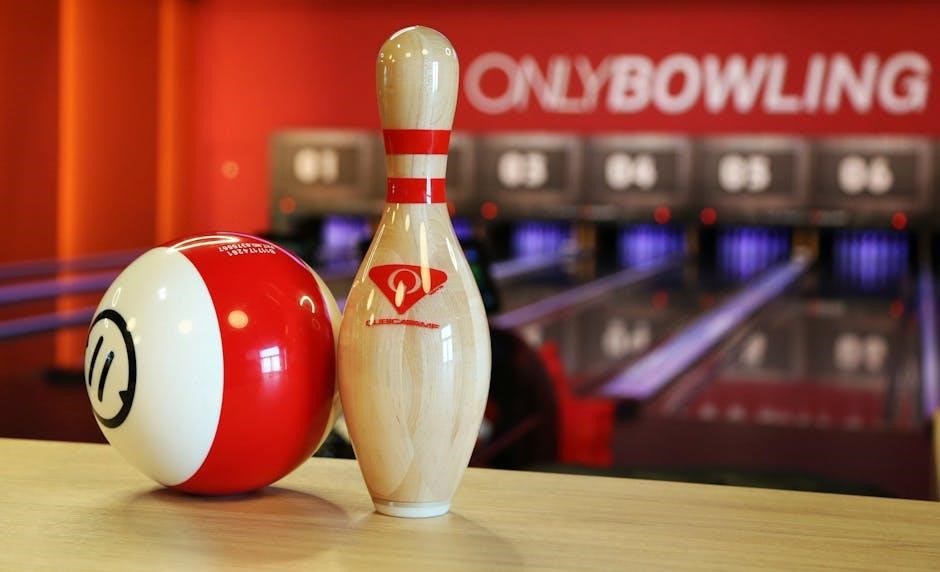
ftc center stage game manual 2
The FTC Center Stage Game Manual 2 provides comprehensive rules, gameplay details, and technical guidelines for the 2023-2024 season, presented by Qualcomm. It outlines objectives, scoring, and robot requirements, ensuring a fair and competitive environment. This manual is essential for teams to understand the game structure, strategy, and compliance standards, fostering innovation and Gracious Professionalism.
1.1 Overview of the FTC Center Stage Game
The FTC Center Stage game, presented by RTX, is the 2023-2024 FIRST Tech Challenge season’s competitive event. Matches occur on a defined playing field with specific elements like Randomization Objects. Teams score points through autonomous and tele-op periods, emphasizing strategy, innovation, and teamwork. The game encourages creative problem-solving and adherence to Gracious Professionalism principles, fostering a dynamic and competitive environment for participants.
1.2 Importance of the Game Manual
The FTC Center Stage Game Manual 2 is a critical resource for teams, detailing rules, scoring systems, and technical requirements. It ensures compliance, fair play, and understanding of the game’s structure. By adhering to the manual, teams can optimize their strategies, build compliant robots, and navigate the competition effectively. Regular updates and clarifications within the manual ensure all teams are aligned with the latest guidelines, fostering a level playing field and promoting Gracious Professionalism.

Game Description and Structure
The FTC Center Stage game involves two alliances of two teams each, competing on a structured field with specific zones and elements to score points effectively.
2.1 Key Components of the Game
The FTC Center Stage game features a structured field with zones like the Grid and Neutral Zone. Key components include alliances of two teams, game elements such as cones, and scoring mechanisms. The match is divided into Autonomous and Tele-Op periods, with teams earning points through cone stacking, platform balancing, and autonomous tasks. Penalties for illegal actions or contact are also outlined to ensure fair play and adherence to rules.
2.2 Playing Field Setup and Layout
The FTC Center Stage playing field is a 12×12-foot grid divided into zones, including the Grid and Neutral Zone. Key elements like cones, platforms, and goal areas are strategically placed. The field features visual references for autonomous navigation and scoring. Teams can find exact dimensions and setup details on the FTC website, ensuring accurate replication for practice and competition environments.
Scoring System and Rules
The FTC Center Stage scoring system rewards points for cone movement, drone usage, and zone control. Penalties deduct points for rule violations. Teams must adhere to all rules to avoid disqualification and ensure fair play.
3.1 Autonomous Period Scoring
The Autonomous Period is a 30-second segment where robots operate independently, earning points through predefined achievements. Scoring includes cone stacking, drone deployment, and zone control. Teams can achieve bonus points for completing specific tasks, such as delivering cones to designated areas or activating mechanisms that trigger additional scoring opportunities. The system rewards precision and efficient programming, emphasizing strategic planning to maximize points during this critical phase of the game.
3.2 Tele-Op Period Scoring
The Tele-Op Period allows driver-controlled robots to score points by manipulating game elements like cones and interacting with zones. Drivers can earn points by stacking cones in designated areas, deploying drones, and controlling specific zones. Bonus points are awarded for efficiency and accuracy in handling game elements. Penalties may apply for improper handling or unauthorized interactions, emphasizing the need for precise driver skills and strategic teamwork during this phase of the game.
3.3 Penalties and deductions
3.3 Penalties and Deductions
Penalties and deductions are enforced to maintain fair play and adherence to game rules. Common infractions include illegal robot contact, unauthorized field interference, and improper handling of game elements. Points are deducted for violations, such as unsportsmanlike conduct or exceeding time limits. Severe or repeated offenses may result in disqualification. Teams must ensure compliance with all rules to avoid penalties and maintain their scoring potential throughout the competition.
Autonomous Period Details
The Autonomous Period focuses on robot performance without driver input, emphasizing precise programming and strategy to maximize scoring achievements within the allotted time frame.
4.1 Autonomous Period Objectives
The Autonomous Period objectives focus on achieving specific tasks like Randomization Tasks and Autonomous Bonuses. Teams must program their robots to complete actions such as scoring elements, navigating to designated zones, and interacting with game elements autonomously. The primary goal is to maximize points during this phase without human intervention, showcasing precise programming and strategic planning to meet predefined challenges and earn rewards efficiently. This phase is critical for overall match success.
4.2 Scoring Achievements in Autonomous Mode
Scoring achievements in Autonomous Mode involve completing specific tasks like Randomization Tasks and Autonomous Bonuses. Teams earn points by programming their robots to perform actions such as scoring elements, navigating to zones, and interacting with game elements. High-value tasks are prioritized to maximize points during the time-limited period. Success requires precise programming, sensor accuracy, and strategic planning to ensure reliable execution and achieve the highest possible score efficiently.
Robot Requirements and Specifications
Robots must meet specific technical guidelines, material restrictions, and dimensional limits outlined in the manual to ensure safety and fair competition. Compliance is mandatory for participation.
5.1 Technical Guidelines for Robot Construction
Robots must adhere to specific design and construction rules, including material restrictions and dimensional limits. Teams must use approved materials like metal, plastic, and 3D-printed parts. Prohibited materials, such as glass or liquids, are strictly forbidden. The robot’s maximum size and weight must comply with the manual’s specifications to ensure safety and fair competition. Additionally, all mechanisms must be designed to prevent damage to the playing field or other robots during matches.
5.2 Permissible Materials and Dimensions
Approved materials include metal, plastic, and 3D-printed parts, while prohibited items like glass, liquids, and excessively sharp components are strictly banned. Robots must not exceed 18 inches in height, 18 inches in width, and 24 inches in length in their starting configuration. The maximum weight is 35 pounds, excluding the battery and motor controllers. These specifications ensure safety, fairness, and compliance with FTC regulations, promoting equal competition among teams.
Field Setup and Game Elements
The playing field features a centralized layout with rendezvous points, balancing stones, and randomization objects. Teams must familiarize themselves with these elements to optimize gameplay and strategy effectively.
6.1 Visual Understanding of the Playing Field
The FTC Center Stage playing field is symmetrically designed with rendezvous points, balancing stones, and randomization objects. The field’s center features spike marks where randomization objects are placed, while rendezvous points are located at the corners. Teams must visualize the field’s layout to strategize effectively, understanding the positions and roles of each element in achieving game objectives. Refer to official documents for precise dimensions and visual aids to enhance gameplay strategy and performance.
6.2 Dimensions and Positions of Game Elements
The FTC Center Stage playing field features specific dimensions for game elements. Rendezvous points are positioned at the corners, while balancing stones and randomization objects are centrally located. The spike marks at the field’s center measure precisely for object placement. Teams must adhere to these measurements to ensure compliance and effective gameplay. Refer to official field setup documents for exact dimensions and positional details to optimize strategy and performance.
Strategies for Success
Maximize scoring by optimizing autonomous routines and tele-op efficiency. Focus on reliable robot performance, strategic game element usage, and consistent execution to achieve higher rankings and success.
7.1 Tips for Optimizing Robot Performance
- Master autonomous routines to ensure consistent scoring during the autonomous period.
- Focus on reliable mechanisms for handling game elements efficiently.
- Prioritize alliance strategy and communication during tele-op for maximum points.
- Regularly test and refine your robot based on performance data.
- Ensure durability and adaptability to withstand the game’s physical demands.
7.2 Effective Use of Game Elements
Maximize scoring opportunities by strategically utilizing game elements such as cones, cubes, and balls. Focus on high-value targets during the autonomous period to secure early points. Ensure efficient manipulation of elements during tele-op, prioritizing placements that align with alliance goals. Effective use of game elements requires precise robot mechanisms and well-coordinated teamwork to achieve optimal scores throughout the match.
Updates and Clarifications
Stay informed about recent changes in the FTC Center Stage Game Manual 2, as updates and clarifications are regularly posted on the official FTC forum, ensuring fairness and accuracy in gameplay rules and interpretations.
8.1 Recent Changes in the Game Manual
The FTC Center Stage Game Manual 2 has been updated to reflect clarifications and rule adjustments for the 2023-2024 season. Key changes include modifications to autonomous period scoring, updated penalties for illegal moves, and revised specifications for robot construction materials. These updates ensure fair play and alignment with competition standards. Teams are encouraged to review the latest version, available on the official FTC website, to stay informed and compliant with all game rules and regulations.
8.2 Forum Rulings and Precedence
Forum rulings issued on the official FTC forum take precedence over the information in the game manuals. Clarifications and interpretations of rules are regularly updated to address team inquiries and ensure consistency. Teams are encouraged to monitor the forum for the latest updates, as these rulings are binding and may impact gameplay strategies and compliance. Failure to adhere to these rulings can result in penalties or disqualification during competitions.
Resources for Teams
Teams can access the game manual, additional materials, and tools for better understanding the game on the official FTC website and forums, ensuring optimal preparation.
9.1 Accessing the Game Manual and Additional Materials
The FTC Center Stage Game Manual 2 and supplementary materials are available on the official Game and Season Info page. Teams can download Game Manual Part 1 and Part 2, along with a one-page description, logo, and game animation. Translated versions of the manual are also provided for global teams. For assistive devices, a text-based English version is available upon request. Additional resources, such as field element dimensions, can be found on andymark.com/FTC.
9.2 Tools for Better Understanding the Game
Teams can utilize the official game animation and one-page description for a visual understanding of gameplay. Audiobook versions of the manual, like the one covering Section 4.0, provide auditory learning options. Additional resources include quizzes and simplified explanations from experienced teams, such as Team Ekam’s video series. The official field documents and Game Element dimensions on andymark.com further aid in preparing for competitions effectively.

Quiz and Preparation
The FTC Center Stage Game Manual 2 includes a quiz to test understanding of rules and strategies. Teams can use quizzes like Team Ekam’s to assess knowledge and prepare effectively for competitions, ensuring clarity and readiness.
10.1 Importance of the Game Manual Quiz
The FTC Center Stage Game Manual Quiz is crucial for ensuring teams fully understand the rules and strategies outlined in the manual. It helps identify knowledge gaps and ensures compliance with game rules, fostering preparedness and clarity. By testing understanding of key sections like autonomous scoring and robot requirements, the quiz enables teams to refine their approach and compete effectively, aligning with FTC’s values of innovation and Gracious Professionalism.
10.2 Key Questions to Focus On
Teams should focus on questions covering game rules, scoring systems, and robot requirements. Key areas include autonomous period objectives, tele-op strategies, and penalty deductions. Understanding game elements like field setup and dimensions is crucial. Additionally, questions on Gracious Professionalism and sportsmanship ensure alignment with FTC values. Focusing on these areas helps teams prepare effectively and compete confidently, addressing both technical and ethical aspects of the competition;

Gracious Professionalism
Gracious Professionalism emphasizes respect, kindness, and collaboration among teams. It promotes ethical conduct, fair play, and support for fellow competitors, embodying FTC’s core values and fostering a positive environment.
11.1 Core Values in FTC Competitions
FTC competitions emphasize core values like Gracious Professionalism, respect, collaboration, and integrity. These values foster a positive environment, encouraging teams to support each other, share knowledge, and celebrate achievements. By prioritizing ethical behavior and sportsmanship, participants create a culture of mutual respect and camaraderie, ensuring everyone benefits from the experience, regardless of competition outcomes.
11.2 Ensuring Fair Play and Sportsmanship
Ensuring fair play and sportsmanship in FTC competitions involves adherence to rules, respectful communication, and ethical behavior. Teams must avoid unsportsmanlike conduct, follow the game manual, and respect opponents, judges, and volunteers. Mentors and coaches play a key role in promoting these values, fostering a culture of mutual respect and collaboration. Fair play ensures an inclusive and positive experience for all participants, aligning with FTC’s commitment to Gracious Professionalism.

Compliance and Adherence
Compliance with all rules and requirements is essential for participation. Teams must adhere to guidelines in the game manual and updates to avoid penalties or disqualification.
12.1 Rules and Requirements for Participation
- Teams must comply with all rules stated in the FTC Center Stage Game Manual 2 and related documents.
- Robot construction must adhere to specified technical guidelines and material restrictions.
- Participation requires proper registration and submission of required documentation.
- Teams must follow field setup, game element dimensions, and competition schedules.
12.2 Consequences of Non-Compliance
- Non-compliance with FTC Center Stage Game Manual 2 rules may result in penalties, disqualification, or match forfeiture.
- Violations of robot specifications or game element misuse can lead to score deductions or loss of rankings.
- Repeated or severe violations may result in removal from competition or ineligibility for awards.
- Teams must address compliance issues promptly to avoid further consequences.